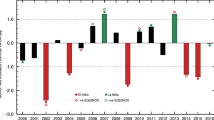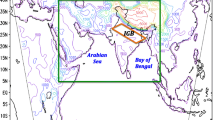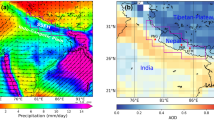Abstract
In this study, the weather research and forecast model coupled with chemistry (WRF-Chem), is used to understand the impact of aerosol–cloud interaction during the active–break cycles of the Indian summer monsoon. Two sets of simulations are performed, one with a fixed aerosol concentration (ConstantAero) and the other with an observation-based prescription of the rate of change of aerosol concentration as a function of precipitation (VaryingAero). This prescription is derived based on satellite-retrieved daily rainrate and concurrent observations of aerosol optical depth from aerosol robotic network. The proposed modification is necessitated by the lack of realistic emission estimates over the Indian region as well as the presence of inherent biases in monsoon simulation in WRF-Chem. In the VaryingAero simulation, unlike in the ConstantAero run, we find that the break-to-active monsoon phase has more cloud liquid water (CLW) and less rain efficiency than in the active-to-break phase. This is primarily due to the indirect effect of increased aerosol loading in the break phase. This result is in accordance with the observed behaviour of CLW estimtes from microwave imager (TRMM 2A12) and radar reflectivity (TRMM precipitation radar). We also find that the proposed interactive aerosol loading results in higher spatial variability in CLW and enhances the likelihood of increased cloud cover via formation of larger clouds. The modification also alters the diurnal cycle of clouds in break and break-to-active phases as compared to other phases due to aerosol loading, with a stronger diurnal cycle of upper level clouds in these phases in the VaryingAero model as compared to ConstantAero model.














Similar content being viewed by others
References
Abhik S, Halder M, Mukhopadhyay P, Jiang X, Goswami B (2013) A possible new mechanism for northward propagation of boreal summer intraseasonal oscillations based on trmm and merra reanalysis. Clim Dyn 40(7–8):1611–1624
Albrecht BA (1989) Aerosols, cloud microphysics, and fractional cloudiness. Science 245:227–1230
Andreae MO (2009) Correlation between cloud condensation nuclei concentration and aerosol optical thickness in remote and polluted regions. Atmos Chem Phys 9(2):543–556. http://www.atmos-chem-phys.net/9/543/2009/
Bergman JW (1997) A numerical investigation of cloud diurnal variations. J Clim 10(9):2330–2350
Bhat G, Chakraborty A, Nanjundiah R, Srinivasan J (2002) Vertical thermal structure of the atmosphere during active and weak phases of convection over the north Bay of Bengal: observation and model results. Curr Sci 83(3):296–302
Bhattacharya A, Chakraborty A, Venugopal V (2014) Variability of cloud liquid water and ice over South Asia from TMI estimates. Clim Dyn 42(9–10):2411–2421
Bollasina MA, Ming Y, Ramaswamy V (2011) Anthropogenic aerosols and the weakening of the South Asian summer monsoon. Science 334(6055):502–505
Chakraborty A, Krishnamurti TN (2008) Improved forecasts of the diurnal cycle in the tropics using multiple global models. Part II: Asian summer monsoon. J Clim 21(16):4045–4067. doi:10.1175/2008JCLI2107.1
Chakraborty A, Satheesh S, Nanjundiah R, Srinivasan J (2004) Impact of absorbing aerosols on the simulation of climate over the Indian region in an atmospheric general circulation model. Ann Geophys Copernic Group 22:1421–1434
Chakraborty A, Krishnamurti TN, Gnanaseelan C (2007) Prediction of the diurnal cycle using a multimodel superensemble. Part II: clouds. Mon Weather Rev 135(12):4097–4116. doi:10.1175/2007MWR2080.1
Chapman EG, Gustafson WI Jr, Easter RC, Barnard JC, Ghan SJ, Pekour MS, Fast JD (2009) Coupling aerosol-cloud-radiative processes in the WRF-Chem model: Investigating the radiative impact of elevated point sources. Atmos Chem Phys 9(3):945–964. http://www.atmos-chem-phys.net/9/945/2009/
Chung CE, Ramanathan V, Kiehl JT (2002) Effects of the South Asian absorbing haze on the northeast monsoon and surface-air heat exchange. J Clim 15(17):2462–2476
Deshpande N, Goswami B (2014) Modulation of the diurnal cycle of rainfall over india by intraseasonal variations of indian summer monsoon. Int J Climatol 34(3):793–807
Dixon M, Wiener G (1993) Titan: thunderstorm identification, tracking, analysis, and nowcasting-a radar-based methodology. J Atmos Ocean Technol 10(6):785–797
Dubovik O, King MD (2000) A flexible inversion algorithm for retrieval of aerosol optical properties from sun and sky radiance measurements. J Geophys Res Atmos 105(D16):20673–20696. doi:10.1029/2000JD900282
Fujinami H, Yasunari T, Morimoto A (2014) Dynamics of distinct intraseasonal oscillation in summer monsoon rainfall over the Meghalaya–Bangladesh–western Myanmar region: covariability between the tropics and mid-latitudes. Clim Dyn 43(7–8):2147–2166
Ghan SJ, Easter RC, Chapman EG, Abdul-Razzak H, Zhang Y, Leung LR, Laulainen NS, Saylor RD, Zaveri RA (2001) A physically based estimate of radiative forcing by anthropogenic sulfate aerosol. J Geophys Res Atmos 106(D6):5279–5293. doi:10.1029/2000JD900503
Goswami B, Venugopal V, Sengupta D, Madhusoodanan M, Xavier PK (2006) Increasing trend of extreme rain events over india in a warming environment. Science 314(5804):1442–1445. doi:10.1126/science.1132027
Goswami BN (2005) South Asian monsoon, 2nd edn. Springer, Chichester
Govardhan G, Nanjundiah R, Satheesh S, Krishnamoorthy K, Kotamarthi V (2015) Performance of WRF-Chem over Indian region: comparison with measurements. J Earth Syst Sci 124(4):875–896. doi:10.1007/s12040-015-0576-7
Grell GA, Peckham SE, Schmitz R, McKeen SA, Frost G, Skamarock WC, Eder B (2005) Fully coupled ”online” chemistry within the WRF model. Atmos Environ 39(37):6957–6975. http://www.sciencedirect.com/science/article/pii/S1352231005003560
Guo L, Turner AG, Highwood EJ (2015) Impacts of 20th century aerosol emissions on the south asian monsoon in the cmip5 models. Atmos Chem Phys 15(11):6367–6378
Hahmann AN, Vincent CL, Pea A, Lange J, Hasager CB (2014) Wind climate estimation using WRF model output: method and model sensitivities over the sea. Int J Climatol. doi:10.1002/joc.4217
Hazra A, Goswami B, Chen JP (2013) Role of interactions between aerosol radiative effect, dynamics, and cloud microphysics on transitions of monsoon intraseasonal oscillations. J Atmos Sci 70(7):2073–2087
Jiang X, Waliser DE, Li JL, Woods C (2011) Vertical cloud structures of the boreal summer intraseasonal variability based on cloudsat observations and era-interim reanalysis. Clim Dyn 36(11–12):2219–2232
Karmakar N, Chakraborty A, Nanjundiah RS (2015) Decreasing intensity of monsoon low-frequency intraseasonal variability over india. Environ Res Lett 10(5):054,018
Kiran VR, Rajeevan M, Rao SVB, Rao NP (2009) Analysis of variations of cloud and aerosol properties associated with active and break spells of indian summer monsoon using MODIS data. Geophys Res Lett. doi:10.1029/2008gl037135
Krishna Moorthy K, Suresh Babu S, Manoj MR, Satheesh SK (2013) Buildup of aerosols over the Indian region. Geophys Res Lett 40(5):1011–1014. doi:10.1002/grl.50165
Krishnamurti T, Kishtawal C (2000) A pronounced continental-scale diurnal mode of the Asian summer monsoon. Mon Weather Rev 128(2):462–473
Lau K, Kim M, Kim K (2006) Aerosol induced anomalies in the Asian summer monsoon: the role of the Tibetan Plateau. Clim Dyn 26(7–8):855–864
Liu J, Li Z (2014) Estimation of cloud condensation nuclei concentration from aerosol optical quantities: influential factors and uncertainties. Atmos Chem Phys 14(1):471–483. http://www.atmos-chem-phys.net/14/471/2014/
Menon S, Hansen J, Nazarenko L, Luo Y (2002) Climate effects of black carbon aerosols in China and India. Science 297(5590):2250–2253
Rajeevan M, Rohini P, Niranjan Kumar K, Srinivasan J, Unnikrishnan CK (2012) A study of vertical cloud structure of the Indian summer monsoon using CloudSat data. Clim Dyn 40(3–4):637–650
Sahany S, Venugopal V, Nanjundiah RS (2010) Diurnal-scale signatures of monsoon rainfall over the Indian region from trmm satellite observations. J Geophys Res Atmos 115:D02103. doi:10.1029/2009JD012644
Satheesh S, Ramanathan V (2000) Large differences in tropical aerosol forcing at the top of the atmosphere and earth’s surface. Nature 405(6782):60–63
Sawamura P, Müller D, Hoff RM, Hostetler CA, Ferrare RA, Hair JW, Rogers RR, Anderson BE, Ziemba LD, Beyersdorf AJ, Thornhill KL, Winstead EL, Holben BN (2014) Aerosol optical and microphysical retrievals from a hybrid multiwavelength lidar data set discover-aq 2011. Atmos Meas Tech 7(9):3095–3112. doi:10.5194/amt-7-3095-2014
Sikka D, Gadgil S (1980) On the maximum cloud zone and the ITCZ over Indian, longitudes during the southwest monsoon. Mon Weather Rev 108(11):1840–1853
Singh C, Thomas L, Kumar K (2015) Impact of aerosols and cloud parameters on indian summer monsoon rain at intraseasonal scale: a diagnostic study. Theor Appl Climatol. doi:10.1007/s00704-015-1640-6
Singh P, Nakamura K (2010) Diurnal variation in summer monsoon precipitation during active and break periods over central india and southern himalayan foothills. J Geophys Res Atmos 115:D12122. doi:10.1029/2009JD012794
Twomey S, Piepgrass M, Wolfe T (1984) An assessment of the impact of pollution on global cloud albedo. Tellus B 36:356–366
Vinoj V, Rasch PJ, Wang H, Yoon JH, Ma PL, Landu K, Singh B (2014) Short-term modulation of Indian summer monsoon rainfall by West Asian dust. Nat Geosci 7(4):308–313
Yasunari T (1981) Structure of an Indian summer monsoon system with around 40-day period. J Meteorol Soc Jpn 59:336–354
Zaveri RA, Easter RC, Fast JD, Peters LK (2008) Model for simulating aerosol interactions and chemistry (MOSAIC). J Geophys Res Atmos. doi:10.1029/2007JD008782
Acknowledgements
AC and VV acknowledge MoES for funding this research. We acknowledge AERONET Team for the valuable data used in this research. We acknowledge data provider of tropical precipitation measuring mission (TRMM) product (3B42) and (TRMM) product (2A25). Analyses and visualizations used in this paper were produced with the Giovanni online data system, developed and maintained by the NASA GES DISC.
Author information
Authors and Affiliations
Corresponding author
Electronic supplementary material
Below is the link to the electronic supplementary material.
Rights and permissions
About this article
Cite this article
Bhattacharya, A., Chakraborty, A. & Venugopal, V. Role of aerosols in modulating cloud properties during active–break cycle of Indian summer monsoon. Clim Dyn 49, 2131–2145 (2017). https://doi.org/10.1007/s00382-016-3437-4
Received:
Accepted:
Published:
Issue Date:
DOI: https://doi.org/10.1007/s00382-016-3437-4




